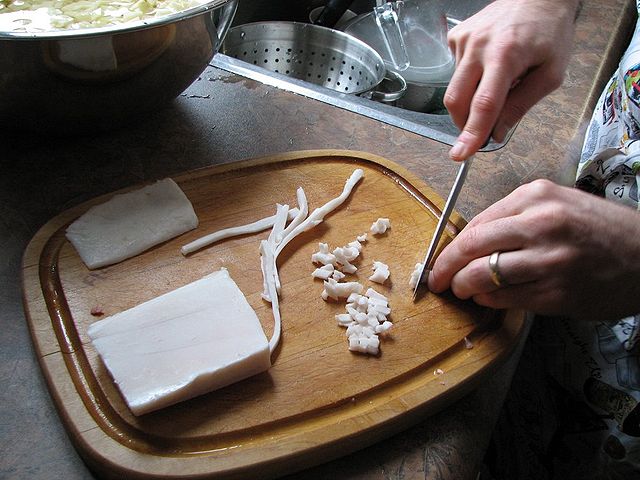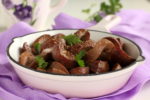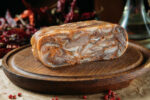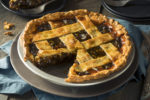
Larding and Daubing Lean Meat
Many kinds of meat which are very lean and dry are improved by the addition of some kind of fat.
Larding is accomplished by cutting strips of salt pork lengthwise with the rind two inches long and one quarter inch wide, and with aid of the larding needle, drawing these pieces through the surface of the meat, taking a stitch an inch long and a quarter inch deep.
The tenderloin or fillet of beef, the thick part of the leg of veal, grouse, and liver, are often prepared in this way.
INFORMATION BELOW FROM 1800s COOKBOOKS
SALT PORK
All pork-butchers sell salt pork for larding. Cut it in slices and then by cutting the slices across it makes square strips or fillets. The strips must be of a proper size to be easily inserted into the larding-needle, and are about two inches and a half long. When the needle is run half way through the meat, insert the salt pork into it, pull the needle off and leave the salt pork inside of the meat, both ends of it sticking out.
If the salt pork is pulled off with the needle, most likely the strips are too small. If, in pulling off the needle, the salt pork does not enter the meat, the strips are too large. If the strips are of a proper size and break while pulling the needle off, then the pork is not good.
To lard, pull slowly, and when the salt pork is far enough into the meat, press on it with the finger and pull the needle and it will then stay in its proper place. It is better to cut a few strips first and try if they are of a proper size.
LARDING-NEEDLE
The best are made of brass. Those that are sold for steel are generally of iron, and break easily. Those for beef à la mode are of steel, and must be flat near the point, in order to cut the meat.
TO LARD
Take a piece of fat salt pork two inches wide and four inches long. Shave off the rind the long way of the pork. Then cut two or three slices about a quarter of an inch thick, the same way as the rind. Cut only to the membrane which lies about an inch below the rind, as this is the firmest part of the pork. Then cut each slice across the width, into strips one quarter of an inch thick.
This will make the lardoons one quarter of an inch wide and thick and two inches long.
Insert one end of the lardoon into the end of the larding needle , then with the point of the needle take up a stitch half an inch deep and one inch wide in the surface of the meat. Draw the needle through, and help the pork to go through by pushing until partly through. Then hold the end of the pork and draw the needle out, leaving the pork in the meat, with the ends projecting at equal lengths, Take up more stitches one inch apart in parallel or alternate rows until the whole surface is covered.
DAUBING is forcing strips of pork through the entire thickness of the meat. Daubing is applied to a broad, thick piece of beef or veal. Cut the pork in strips one third of an inch wide and thick, and as long as the meat is thick. Punch a hole clear through the meat with a steel, and then insert the lardoon with a large larding needle or with the fingers.
The salt and fat from the lardoons penetrate the inside of the meat, and by many are considered an improvement. The process is not difficult, requiring no more skill than any other kind of sewing.
This very short video shows how to use one type of larding needle.
MAKING BEEF A LA MODE
Take four to six pounds from the under part of the round of beef, cut thick. Wipe, and trim off the rough edges. Put it in a deep earthen dish, arid pour over it spiced vinegar, made by boiling for five minutes one cup of vinegar, one onion, chopped fine, three teaspoonfuls of salt, and half a teaspoonful each of mustard, pepper, cloves, and allspice.
Let the meat stand several hours, turning it often. Then daub it with ten or twelve strips of salt pork, cut one third of an inch wide, and as long as the meat is thick, inserting them with a larding needle or carving-steel. Dredge with flour.
Cut two onions, half a carrot, and half a turnip fine, and fry them in fat or drippings until brown. Put them in the stewpan. Then brown the meat all over in the fat. Put it on a trivet in the pan, and half cover with boiling water. Add one tablespoonful of mixed herbs, tied in a small strainer cloth. Cover closely, and simmer four hours, or until tender. Take it up carefully, remove the strings, and put it on a large platter. Remove the fat from the gravy, add more seasoning, and thicken with flour wet in a little cold water. Boil eight minutes, and strain it over the meat.
LARDED CALF’S LIVER
Take a calf’s liver and wash it well. Cut into long slips the fat of some bacon or salt pork, and insert it all through the surface of the liver by means of a larding-pin. Put the liver into a pot with a tablespoonful of lard, a little water, and a few tomatoes, adding one large onion minced fine, and some sweet marjoram leaves rubbed very fine. The sweet marjoram will crumble more easily if you first dry it before the fire on a plate. Having put in all these ingredients, set the pot on hot coals in the corner of the fireplace and keep it stewing regularly and slowly for four hours. Send the liver to table with the gravy round it.



One thought on “Larding and Daubing Lean Meat”
Never heard of larding and daubing before even though it is still done. Interesting.